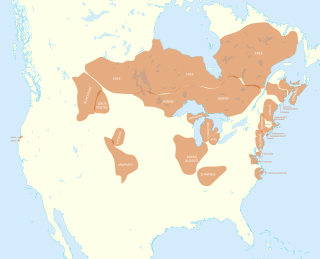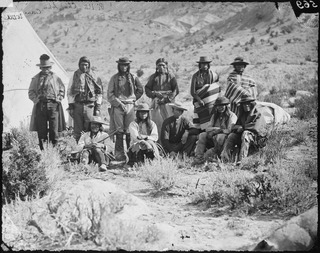The Ute mythology is the mythology of the Ute people, a tribe of Native Americans from the Western United States.

The Algic languages are an indigenous language family of North America. Most Algic languages belong to the Algonquian subfamily, dispersed over a broad area from the Rocky Mountains to Atlantic Canada. The other Algic languages are the Yurok and Wiyot of northwestern California, which, despite their geographic proximity, are not closely related. All these languages descend from Proto-Algic, a second-order proto-language estimated to have been spoken about 7,000 years ago and reconstructed using the reconstructed Proto-Algonquian language and the Wiyot and Yurok languages.
Rinpoche, also spelled Rimboche and Rinboku, is an honorific term used in the Tibetan language. It literally means "precious one", and may refer to a person, place, or thing—like the words "gem" or "jewel".
Alfred Irving "Pete" Hallowell was an award-winning American anthropologist, archaeologist and businessman.
William N. Fenton was an American scholar and writer known for his extensive studies of Iroquois history and culture. He started his studies of the Iroquois in the 1930s and published a number of significant works over the following decades. His final work was published in 2002. During his career, Fenton was director of the New York State Museum and a professor of anthropology at the State University of New York.

The bile up is considered the cultural dish of the Kriols of Belize. It is a combination of boiled eggs, fish and/or pig tail, with cassava, yams, or sweet potatoes, plantains, and tomato sauce.

Walter Hough, Ph.D. (1859–1935) was an American ethnologist who worked for the Smithsonian Institution.
Edward Pasqual Dozier was a Pueblo Native American anthropologist and linguist who studied Native Americans and the peoples of northern Luzon in the Philippines. He was the first Native American to earn a PhD in anthropology in the United States.
Bride service has traditionally been portrayed in the anthropological literature as the service rendered by the bridegroom to a bride's family as a bride price or part of one. Bride service and bride wealth models frame anthropological discussions of kinship in many regions of the world.

The Pueblo clowns are jesters or tricksters in the Kachina religion. It is a generic term, as there are a number of these figures in the ritual practice of the Pueblo people. Each has a unique role; belonging to separate Kivas and each has a name that differs from one mesa or pueblo to another.

Cora Alice Du Bois was an American cultural anthropologist and a key figure in culture and personality studies and in psychological anthropology more generally. She was Samuel Zemurray Jr. and Doris Zemurray Stone-Radcliffe Professor at Radcliffe College from 1954. After retirement from Radcliffe, she was Professor-at-large at Cornell University (1971–1976) and for one term at the University of California, San Diego (1976).

Elsie Worthington Clews Parsons was an American anthropologist, sociologist, folklorist, and feminist who studied Native American tribes—such as the Tewa and Hopi—in Arizona, New Mexico, and Mexico. She helped found The New School. She was associate editor for The Journal of American Folklore (1918–1941), president of the American Folklore Society (1919–1920), president of the American Ethnological Society (1923–1925), and was elected the first female president of the American Anthropological Association (1941) right before her death.
The Nacotchtank were an indigenous Algonquian people who lived in the area of what is now Washington, D.C., during the 17th century. The Nacotchtank village was within the modern borders of the District of Columbia along the intersection of the Potomac and the Anacostia river.
Jeffrey H. Cohen is an American anthropologist.

Ute music constitutes the music of the Indigenous Northern American Ute tribe. Much of this music has been recorded and preserved. Each song of the Ute tribe has a meaning or is based on an experience. These experiences may be social, religious or emotional. Many Ute songs are social songs. They include war songs, social dance songs, parade songs, medicine songs, love songs, game songs and story songs.

Language and Mind is a 1968 book of three essays on linguistics by Noam Chomsky. An expanded edition in 1972 added three essays and a new preface.
The Family Among the Australian Aborigines: A Sociological Study is a 1913 anthropological book by the Polish scholar Bronisław Malinowski.
Marlene Dobkin de Rios was an American cultural anthropologist, medical anthropologist, and psychotherapist. She conducted fieldwork in the Amazon for almost 30 years. Her research included the use of entheogenic plants by the indigenous peoples of Peru.

Language and Linguistics: An Introduction is a 1981 book by Sir John Lyons.

Sharlotte Kathleen Neely is an American anthropologist who is known for her research on Native North Americans, especially the Cherokee Indians. As of 2017, she was Professor Emerita of Anthropology at Northern Kentucky University.










